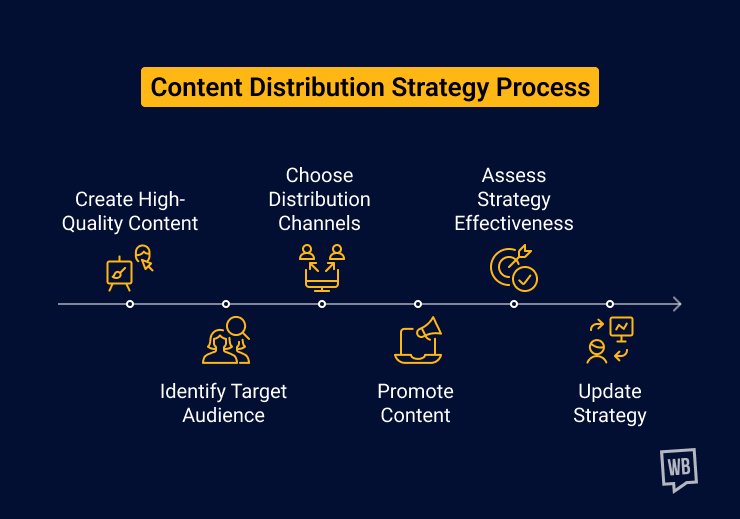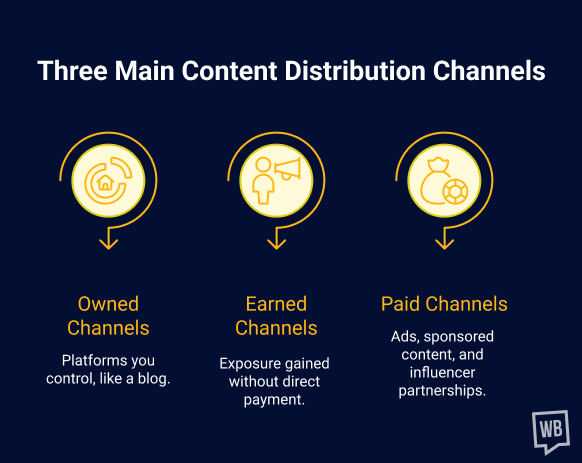A well-crafted piece of content is valuable only if it reaches the right audience at the right time. That’s where refining your content distribution strategy comes in. By improving how and where you share your content, you can increase visibility, engagement, and conversions.
This comprehensive guide will help you understand how you can refine your content distribution strategy, combining proven frameworks, real-world practices, and actionable tips.
What Is a Content Distribution Strategy?

Content distribution is the process of getting your content in front of the right people at the right time. Even if high-quality content is created, the way it is shared has a direct effect on how well it reaches and resonates with its intended audience.
Over time, distribution strategies can become less effective. The digital world is always changing, and what works today may not work tomorrow.
Many factors influence whether a content distribution approach continues to deliver results. Regular assessment helps identify if a strategy is still on track or if it requires updates to stay relevant.
A content distribution strategy is the structured plan for getting your content in front of your target audience. It answers:
- Where will your content live?
- How will it be promoted?
- Who will see it?
- When is the best time to share it?
The goal is to maximize visibility, engagement, and conversions while minimizing time and resources. For deeper insights into B2B content distribution strategies, check out:
Why Refining Your Strategy Matters
Even if you already have a strategy, refining it regularly ensures:
- Alignment with audience behavior — Platforms and habits change quickly.
- Better ROI — Resources are focused on high-performing channels.
- Higher engagement — Messaging becomes more relevant.
- Competitive advantage — Keeps you ahead of slower-moving competitors.
Think of refining as tuning an engine: small adjustments can deliver big performance gains.
The Three Main Content Distribution Channels

A balanced strategy usually includes all three:
- Owned Channels — Platforms you control (blog, email newsletter, brand social pages).
- Earned Channels — Exposure you don’t pay for (shares, mentions, guest posts).
- Paid Channels — Ads, sponsored content, influencer partnerships.
If you want to understand how content ties into sales and ROI, explore:
10 Core Steps to Refine Your Content Distribution Strategy
Drawing from both marketing frameworks and practical experience, here are the eight essential steps:
1. Set a Clear Content Distribution Goal
The first step in refining your content distribution strategy is defining exactly what you want to achieve. Without a clear goal, you risk wasting time and resources on content that doesn’t move the needle.
Example goals include:
- Increasing brand awareness in a new market
- Driving 20% more traffic to your website in 3 months
- Generating 200 new qualified leads from LinkedIn campaigns
- Boosting customer retention through educational email series
Pro Tip:
Make your goals SMART — Specific, Measurable, Achievable, Relevant, and Time-bound. For example, instead of saying "increase reach," say "increase organic LinkedIn post impressions by 30% within 90 days."
2. Conduct a Detailed Content Audit
Before you create new content, evaluate what you already have. A content audit helps you identify:
- Top performers you should promote more
- Outdated content that needs updates
- Gaps where new content is required
How to do it:
- List all your blog posts, videos, social media posts, and other assets.
- Use analytics tools like Google Analytics, HubSpot, or Semrush to check performance metrics.
- Tag content as keep, update, or remove.
Example:
If you discover that an old blog post on “Instagram marketing tips” is still bringing in traffic, you can refresh it with the latest trends and repromote it across social media and newsletters.
Learn more about revitalizing your content marketing to maximize returns from older assets:
3. Identify Your Audience’s Preferred Channels
Knowing your audience is at the heart of any content marketing strategy. You need to understand where they spend time and how they consume content.
Ways to find out:
- Surveys & polls: Ask your audience directly.
- Social listening tools: Use tools like Brandwatch or Sprout Social to monitor conversations.
- Analytics: Check referral traffic sources in Google Analytics.
Example:
If you’re targeting B2B decision-makers, LinkedIn might outperform Instagram. If you’re selling beauty products, Instagram Reels and TikTok could be your best bets.
To better align distribution with buyer intent, check out:
4. Adapt Content to Each Platform
Not all platforms are created equal. Posting the exact same content everywhere is a quick way to lose engagement. Instead, tailor your format, tone, and style for each channel.
Example adaptations:
- LinkedIn: Long-form posts with industry insights.
- Instagram: Visual storytelling with short captions.
- Twitter/X: Quick, punchy updates with trending hashtags.
- YouTube: In-depth tutorials or explainer videos.
Pro Tip:
Use content repurposing. For example, turn a webinar into a blog post, then into short video clips for social media.
5. Test New Distribution Channels
Even if you’ve found success on certain platforms, don’t get too comfortable. Audience behavior changes, and new opportunities appear all the time.
How to test:
- Run A/B tests with different headlines, posting times, and formats.
- Allocate a small percentage of your budget to experimenting with emerging platforms.
- Track results and decide whether to scale up.
Example:
If your brand has never used Pinterest, test posting infographics there for a month and monitor referral traffic.
6. Align Your Distribution with Sales Initiatives
Your marketing and sales teams should work together, not in silos. When your content supports specific sales goals, the results are much stronger.
Ways to align:
- Share content calendars with your sales team.
- Create sales enablement content like case studies or comparison charts.
- Promote content during sales campaigns for consistent messaging.
Example:
If your sales team is targeting enterprise clients this quarter, you can produce a series of LinkedIn articles highlighting enterprise-level solutions.
7. Track, Analyze, and Refine Regularly
Your strategy shouldn’t be static. Use data-driven insights to tweak and improve it over time.
Key metrics to track:
- Click-through rates (CTR)
- Engagement rates (likes, comments, shares)
- Conversion rates
- Cost per lead (CPL)
Pro Tip:
Schedule a quarterly review of your strategy to ensure it’s still relevant and competitive.
8. Use AI Tools to Optimize and Scale Your Content Distribution
AI can save time, improve quality, and tailor content for platforms.
Content Rewriting & Enhancement: Quillbot, Grammarly, Copy.ai, Jasper, Wordtune
Creativity & Idea Generation: Sudowrite, ChatGPT
Productivity & Workflow: Sapling AI, Frase.io
Pro Tip: Integrate AI tools into your workflow to speed up production, maintain a consistent brand voice, and improve SEO.
9. Automate Content Distribution with UTM Tracking
Automation saves time and keeps your strategy consistent. Use tools to schedule posts, send emails, and manage your workflow.
Tools: Social media schedulers, email automation, workflow management systems.
UTM Tracking: Add UTM tags to every link (utm_source, utm_medium, utm_campaign) to see where traffic and leads are coming from.
Tip: Keep UTM naming consistent across all campaigns. This makes it easy to track results and optimize your strategy.
Here’s a complete guide to UTM best practices to ensure accurate tracking and reporting:
10. Plan a Content Calendar
A content calendar organizes what to post, when, and where. It helps maintain consistency and ensures your audience sees the right content at the right time.
Tips:
- Align posting frequency with audience habits
- Mix evergreen and timely content
- Repurpose top-performing content for multiple formats
Examples:
- Blog → LinkedIn carousel → short video clips
- Webinar → Email series → social snippets
- Case study → Thought-leadership articles
Build Authority Alongside Distribution
Refining your content distribution is essential, but distribution alone won’t guarantee impact. To truly stand out, your content must be seen as credible and trustworthy by your audience. That’s where The Authority Edge Framework comes in.
This framework helps you:
- Position your content as a thought leader in your industry
- Build trust with your target audience
- Leverage AI without losing authenticity
- Convert authority into measurable business growth
FAQs on Refining Your Content Distribution Strategy
1. What is a content distribution strategy?
It’s the plan for delivering your content to your target audience through the most effective channels to achieve your marketing goals.
2. How often should I update my distribution strategy?
At least every quarter, or sooner if your audience behavior changes significantly.
3. How often should B2B companies review their content distribution strategy?
Quarterly reviews work best for major strategy changes, while monthly reviews optimize performance based on recent data. Market conditions and platform algorithm updates often drive timing more than fixed schedules.
4. Which attribution models work best for B2B multi-channel content distribution?
Time-decay and position-based attribution models work better than first-touch or last-touch models for B2B marketing. These models account for multiple touchpoints throughout longer buying processes and provide more accurate views of channel influence.
5. Can small marketing teams refine distribution strategies without expensive automation tools?
Small teams can start with free analytics tools and manual tracking methods. Focusing on process improvements and basic data analysis provides sufficient insights before investing in premium automation platforms.
6. How long does it take to see results after optimizing the content distribution strategy?
Engagement metrics like clicks and shares typically show changes within 2-3 weeks after optimization. Revenue-related results usually take 2-3 months due to longer B2B sales cycles and attribution delays.
Final Thoughts
Now that you know how you can refine your content distribution strategy, remember, it’s not a one-time fix but an ongoing process. By setting clear goals, auditing content, understanding your audience, and using AI and automation, you’ll ensure your content consistently reaches the right people at the right time.
The result? More reach, stronger engagement, better leads, and higher conversions. Start small, track results, and keep improving, even small adjustments can create big growth over time.

%20(1).webp)
